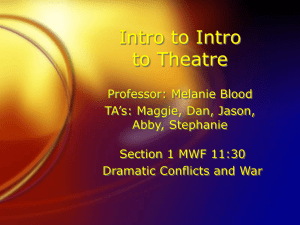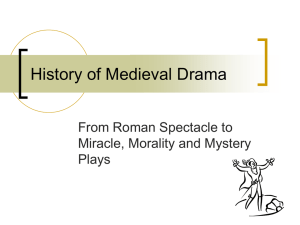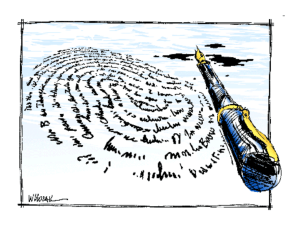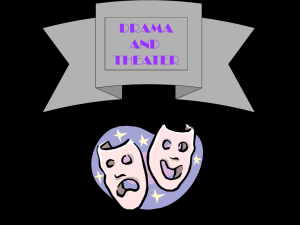Lecture 1 - WordPress.com
advertisement
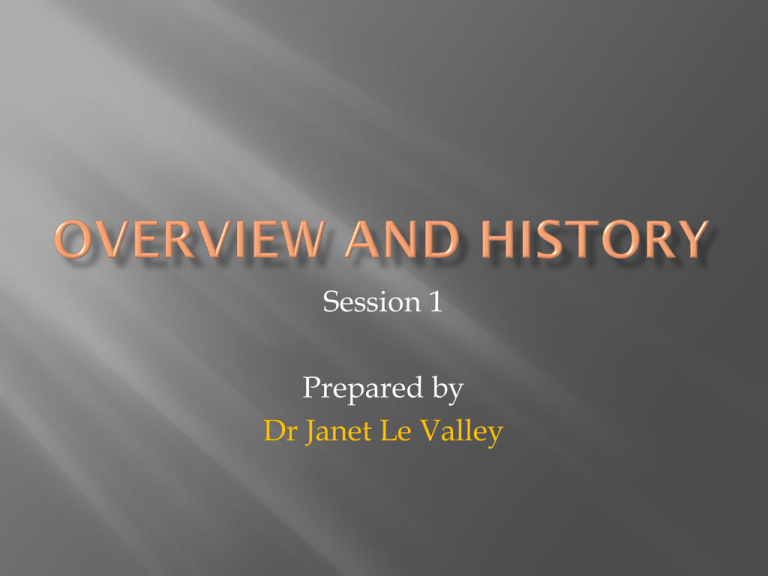
Session 1 Prepared by Dr Janet Le Valley Dramatherapy is the intentional and systematic use of drama and theatre processes to achieve healthy psychological growth and change. Dramatherapy reaches far beyond a single discipline, drawing freely from concepts of psychology, theatre/drama, psychoanalytical theory, anthropology and theories of child development. The word drama comes from ancient Greek and means quite literally “things done” (Harrison, 1913). Drama therapy is, in simplest terms, the use of action techniques, particularly role play, drama games, improvisation, puppetry, masks, and theatrical performance, in the service of behavior change and personal growth. It has its roots in religion, theatre, education, social action, and mental health/therapy 1.Role-playing: Explores life experience through the creation of an imaginary environment 2.Using objects and materials: Handles and resolves problematic feelings, relationships or experiences 3.Wearing masks and costumes: Depicts the self and self-image 4.Using play, storytelling and fable: Searches for problems within events or issues 5.Creating “ritual”: Acknowledges change or milestones in life 6.Acting in progressive stages: Develops new ways to connect to the self or others 1. Dramatic projection The clients project their inner conflicts onto a visible image in drama to produce space for dramatic dialogue. The process helps clients to realize their inner conflicts, enable change, create new relationships with others, and eventually readjust their inner world. 2. Therapeutic performance process Therapeutic performance process allows clients to express their unresolved issues. Clients identify problems and realize their issues through different role-playing. During the process, clients change their perception and search for solutions to their problem or choose a new direction in which to go. 3. Drama-therapeutic empathy and distancing Empathy encourages emotional resonance, identification and emotional involvement. During the therapeutic process, clients develop their empathic response and improve their relationships with others. Distancing encourages an involvement which is more orientated towards creative thought, reflection and perspective. Gradually, the clients develop and transform between these two processes. 4. Personification and impersonation The clients express an issue, feeling or personality within a dramatic framework. The process provides an opportunity for the client to explore himself and experience what it is like to be another. In addition, the process helps the client to understand his problem of which he is situated and eventually develop the ability to reconnect with others. 5. Interactive audience and witnessing The clients and the audience encounter and affect each other during the dramatic reflection process. They observe and benefit from the motivation of mutual support, and finally achieve a “peak experience” within the encounter. 6.Embodiment: dramatizing the body Embodiment simply entails a process through which clients recognize their physical potential and body language through dramatic performance. During the process, the client changes personal identity by entering a role, induces a new observation, perspective and release, and explores the image, emotional hurt or distress as it relates to the body. 7. Playing Drama therapy creates new relationships with playful reality. The client is empowered to deal with events, concepts and consequences with an attitude of creativity, experimentation and flexibility. Playing is related to the continuity and development of cognition, emotion and relationship with others. A collaborative environment helps the client to face the self and life experience, and is allowed to disregard the development stage of solitude. Decisions and actions are experienced without judgment. Clients are free to make mistakes because it is play. 8. Life-drama connection Drama therapy refers to the process where clients can apply their life experience without creating serious consequences. The client is separated from the reality and receives satisfaction from exploring the unconscious. The life-drama connection reflects the real life of the client through constructed drama. Dramatic representation flows between the objective and subjective, making "real life" more comfortable and safe while enabling the client to go on a “creative adventure.” 9. Transformation Transformation can be seen within the many aspects of dramatic process. We observe clients develop and transform, and these changes are therapeutic. The clients develop the new ability of verbal expression, feeling and response through drama therapy. They participate in the production process of drama, satisfy their desire to create, rearrange their thoughts, values, emotions, and finally respond to themselves and the world. The relationship that the client forms with their drama therapist and other group members is also transformative. Drama is a personal experience Creative action is added to therapeutic support so that action communicates client struggle In a dramatherapy session we can explore dream images and discover meaning. It is also possible to rework nightmares and indeed in dramatherapy we can dream while still awake: only being able this time to control the dream. Moreno who invented psychodrama said to Freud, “You analysed their dreams, I try to give them courage to dream again.” Drama therapy can be seen as a set of constructed and controlled experiments to provide a new way of life with imagination, intellect and spirit. Evidence in archeological records suggests that early humans began to make art – paintings, sculpture, music, dance, and drama – during the Upper Paleolithic period about 45,000-35,000 years ago. Experts marvel at the suddenness with which the arts burst onto the human scene and tie it to the beginnings of symbolic, metaphoric thought (Pfeiffer, 1982; Mithen, 1996; Lewis-Williams, 2002). Simultaneous with this creative explosion, shamans and priests began utilizing the arts in their healing and religious practices. The origins of the arts and religion seem to be intertwined because the arts naturally provided effective symbolic ways to express abstract religious ideas. Dance and drama, in particular, were extremely useful in rites to create sympathetic and contagious magic as well as to embody myths and rituals. Scholars have hypothesized about those origins, based on surviving cave paintings, artifacts, myths, and even on extrapolating from contemporary shamanistic practices (Pfeiffer, 1982; Lewis-Williams, 2002). Cultural anthropologist Jane Ellen Harrison, for instance, theorizes that early art developed directly out of ritual from mimesis or imitation of an experience and became an abstract representation or metaphor which was then available for magical use (Harrison, 1913). Eventually, the art form of theatre developed out of religious rites and rituals. Western theatre history usually begins its formal accounts with ancient Greek theatre. Religious festivals dedicated to Dionysus, god of fertility and revelry, featured theatrical competitions in which plays brought mythology to life for the community. The Great Dionysia, held in Athens in early spring, featured tragedies, comedies, and satyr plays written by citizen-poets and performed by citizen-actors for the entire populace. During a choral presentation at one of these festivals around 560 B.C. Thespis, the first actor, stepped away from the chorus to take on an individual character for the first time and theatre, as we know it, was born (Brockett, 1968). The first written theoretical account of drama therapy can be found in connection with Greek theatre. In his Poetics, Aristotle says the function of tragedy is to induce catharsis – a release of deep feelings (specifically pity and fear) to purge the senses and the souls of the spectators (Aristotle, trans. 1954). According to Aristotle, drama’s purpose is not primarily for education or entertainment, but to release harmful emotions which will lead to harmony and healing in the community (Boal, 1985). In his analysis of Aristotle’s work, Brazilian director Augusto Boal (1985) suggests that this cathartic release helped preserve the status quo in Greek society, for a populace that is content and at peace will not rebel against the rulers in power. Aristotle’s ideas about catharsis have influenced many psychotherapy models from Freudian psychoanalysis onward by focusing psychotherapeutic work on the idea that insight into troubling emotional issues and healing occurs only after the patient has achieved catharsis. This process is disputed as unrealistic and unnecessary by cognitivebehavioral therapists, rational-emotive therapists, and others who feel that catharsis and insight are not enough to induce healing or change, that new thoughts and behaviors must be learned to replace the old, and that change doesn’t automatically follow emotional release and understanding. Circa 150 AD Soranus, a Roman, believed that the way to cure mentally ill patients was to put them into peaceful surroundings and have them read, discuss, and participate in the production of plays in order to create order in their thinking and offset their depression (Cockerham, 1991). 5th Century AD Caelius Aurelius, in his treatise On Acute Diseases and on Chronic Diseases, advocated that patients suffering from madness should go to the theatre. For depression, see a comedy; for mania or hysteria, see a tragedy: the aim being to match the mental disturbance with its opposite and help attain a balanced state. The patient then progressed to delivering speeches. Rome. (Jones, 1996, 45-6). 1528 Wolsey encouraged drama in school at Ipswich (Courtney, 1968, 14) 16th Century: Nicholas Udall writes Ralph Royster Doister which is the first English comedy which is performed by school children at Eton and Westminster. In the play he states that the benefit of comedy is that is “prolongeth life and causeth health”. Sir Thomas Elyot recommended dramatic dancing in education; Sir Francis Bacon values theatre in developing confidence: “stage-playing; an art which strengthens the memory, regulates the tone and effect of the voice and pronounciation, teaches a decent carriage of the countenance and gesture, gives not a little assurance, and accustoms young men to bear being looked at.” (Courtney, 1968, 15) 1606 The earliest performance of Shakespeare’s King Lear: on the wild heath Lear addresses an empty stool as his daughter Goneril in a “psychodramatic” trial. Later in the play Edgar uses a guided fantasy and enactment to help his suicidal father (Gloucester). He states: “Why I do trifle thus with his despair is done to cure it.” Act 4, scene 6, 33. 1613-14 Shakespeare and Fletcher write The Two Nobel Kinsmen, in which a woman goes mad and is healed by a psychodramatic enactment: a doctor prescribes the treatment. He is deliberately using the dramatic “as if”. The doctor states that this is not an innovation but normal clinical practice: “I have seen it approved, how many times I know not, but to make the number more, I have great hope in this.” (4.3.91). This is the first of five Jacobean plays in which drama is used for therapeutic purposes. 1616 John Fletcher writes The Mad Lover which makes use of masques to prevent suicide. 1619-22 Fletcher and Philip Massinger write A Very Woman, a tragicomedy, in which Doctor Paulo uses drama for therapeutic purposes. 1615 – 1625 Fletcher wrote and Middleton revised a comedy titled alternately, The Nice Valour or The Passionate Madman, in which masques are used in an attempt to treat a man whose diagnosis might be erotomania! 1621-5 In John Ford’s play The Lover’s Melancholy, Dr. Corax uses drama to treat depression and grief. He stages several therapeutic dramas including The Masque of Melancholy. 1668 Hans Jakob Christoffel von Grimmelshausen writes in his ?Simplicissimus? (book 2, chapter 13) that doctors used symbolic enactments in the treatment of delusions: e.g. one man “thought he had already died and wandered around as a ghost, refusing both medicine and food and drink until a clever doctor paid two men to pretend they were ghosts, but ones who loved to drink. They joined the other and persuaded him that modern ghosts were in the habit of eating and drinking, though which he was cured.” Germany. 1761 Sauvage uses theatre in the treatment of psychiatric patients, France (Petzold, 1973)This is possibly L’Abbe Francois Boissier de Sauvages de la Croix, botanist, theologian and physician, Professor of philosophy at the College of Went. 1775-7 Johann Wolfgang von Goethe writes Lila: a play in which a woman suffering a psychotic grief reaction is healed by a Doctor Verazio, her relatives and friends who play out her delusions and hallucinations and so bring her back, through this dramatised fantasy, to reality. 1788 ”in the large Lunatic Hospital near Paris, the Patients were encouraged to Act Plays, this pleasing remedy has been found to be very conducive to their recovery.” Black, 1788. (Hunter & Macalpine, 1964, 644) 1790s Dr. Philippe Pinel, founder of enlightened psychiatry in France, stages a “psychodramatic” trial to cure a patient of his delusion that he was going to be executed. (Porter, 2002, 105) 1803 J. C. Reil publishes Rhapsodies on the application of psychic cure method of mental disorders, an entire program for the treatment of mental illness, recommends the establishment of a Therapeutic Theatre, Germany. 1843 William A. F. Browne, former student at Charenton (see 1811) encourages mental patients to perform plays (including Twelfth Night) at the Crichton Royal Institute, Dumfries, Scotland. 1847 Patients of the Utica New York State Lunatic Asylum, USA, put on a “great bill” of theatre including an original play in 3 acts (Reiss, 2008, 54). 1850s John Galt, superintendent of a state asylum in Virginia, USA, was influenced by Reil to use comedy to supplant delusional ideas (Reiss, 2008, 59). 1855 D. Tilden Brown at Utica wrote that for patients involved in theatre, “undoubted benefits have accrued from the intellectual application, mental discipline, exercise of memory, and self-control of the performers, and from the diffusion of good humour and hilarity among the observers” (Reiss, 2008, 61). 1891 Janet, French pioneer of Psychological Analysis, uses hypnosis and drama to re-enact traumatic scenes, to achieve catharsis and modify the patient’s fixed ideas. 1898 F. M. Alexander, actor, begins to study his own use of himself to resolve voice difficulties and subsequently develops the Alexander technique, Australia. 1904 Freud writes on the psychopathological characters on stage: and points to the therapeutic potential of theatrical play. He does not publish this paper until 1948 and never referred back to this approach again. 1905 Stanislavski suggests actors use improvisation during rehearsal: such are the objections of Meyerhold and Danchenko that he abandons the idea which 30 years later he formulates as the law for the analysis of a play and a role. 1908 Dr. Eugen Bleuler introduces the term schizophrenia. He encourages patients “to take part in theatricals.” (Ellwood, 1995, 24) 1908 – 17 Vladimir Iljine (influenced by Stanislavski) develops his Therapeutic Theatre in a psychiatric hospital, Kiev, Russia. 1909 Iljine publishes Improvising Theatre Play in the Treatment of Mood Disorders in Kiev, Russia 1910 Iljine publishes Patients Play Theatre: a way of healing body and mind, Kiev, Russia. 1910 Jane Addams publishes 20 Years at Hull-House: she describes the value of drama in recreation, education and selfexpression, Chicago. 1911 Neva Boyd begins to promote play activities for children, Chicago. 1913 C. G. Jung develops Active Imagination as a method of encountering the unconscious using visualisation, conversations with inner figures, play with objects and painting, Switzerland. 1920 Sandor Ferenczi, psychoanalyst addresses the 6th International Congress of Psycho-Analysis on The Further Development of an Active Therapy in Psycho-Analysis, describing his use of role play/drama in individual therapy. 1927 Evreinoff publishes The Theatre in Life (including a chapter on Theatrotherapy) in New York, U.S.A. 1927 Roberto Assagioli publishes A New Method of Treatment – Psychosynthesis (using visualisation and image work), Italy. 1928 Peter Slade begins to use dance drama with his fellow pupils who had joined together in a Suicide Club at boarding school. After the enactments “helped young men not to kill themselves after all, but to find hope and try to believe life must be better after school…we could all see & feel the difference after such sessions…became my life’s work to explain.” (Slade, 2000) 1929 Margaret Lowenfeld, child psychotherapist, develops Sandplay as a form of playtherapy. The first recorded use of the word Dramatherapy was by Peter Slade, who in the 1930's referred to all forms of carefully applied Drama as Dramatherapy. 1933 T. D. Noble, a psychiatrist at Sheppard-Pratt Hospital in Baltimore, USA, noticed that patients who had acted in the hospital plays were able to understand emotions better than other patients, could link their present emotional state and behaviour to their earlier trauma more easily, and were able to experiment with alternative modes of behaviour. He found drama was a vehicle for the discovery and expression of conscious and unconscious conflicts; that playing other characters helped patients release repressed emotions; that drama encouraged socialization. (Phillips, 1994). 1943 – 7 (dates approximate) Gertrud Schattner (see 1981) did drama, storytelling and poetry with depressed patients in a Swiss tuberculosis sanatorium. Through their participation in drama, patients began to recover (Schattner, 1981; Reiter, 1996). 1944-7 Theatro-therapy, group psychotherapy, started for psychotic children in Saint Alban Hospital with Dr. F. Tosquelles, psychiatrist/analyst, France. 1964 – 9 F. Perls, trainer of Gestalt at the Esalen Institute, California, gives public demonstrations “very much a synthesis of drama and therapy”. Influences Anna Halprin, Gabrielle Roth. 1966 Jennings meets Lindkvist; Sue Jennings and Gordon Wiseman found the Remedial Drama Group and tour hospitals and centres for people with profound learning difficulties: Germany, Holland, Belgium and U.K.. 1976 British Association for Dramatherapy founded. 1976 Queen Margaret College, Edinburgh, runs the first undergraduate course in dramatherapy: the validation of this course led to approval of other courses in th UK. 1977 The first dramatherapy diploma starts at Hertfordshire College of Art and Design. 1978 Lev Vygotsky describes in Mind in Society the importance of play in developing social identity in children. 1979 National Association for Drama Therapy established in U.S.A. 1979 Thomas Scheff publishes Catharsis in Healing, Ritual and Drama, California. 1980 Grotowski in Mexico works with Nicholas Nunez who develops Anthropcosmic Theatre: a ritual theatre of meditation, movement and awareness. 1989 The Whitley Council recognises dramatherapists in N.H.S., providing a career structure. 1993 The UKCP (United Kingdom Council for Psychotherapy) inaugurated: the British Psychodrama Association represents psychodrama in the HIPS Section (Humanistic and Integrative Psychotherapy). 1997 By act of Parliament dramatherapy becomes a state registered profession (in the C.P.S.M.: later to become the H.P.C.). 2014 Following Ravindra’s published books on Dramatherapy, the first dramatherapy training program commences at Samutthana, King’s College Centre in Sri Lanka, with Ravindra and Dr. Janet. Depending on the goals and needs of the client, the drama therapist chooses a method (or several) that will achieve the desired combination of understanding, emotional release, and learning of new behavior. Some methods, such as drama games, improvisation, role play, developmental transformations, sociodrama and psychodrama are very process-oriented and unscripted. The work is done within the therapy session and not presented to an audience. Other methods, such as Playback Theatre, Theatre of the Oppressed, and the performance of plays are more formal and presentational, involving an audience. Puppets, masks, and rituals can be used as part of performance or as process techniques within a therapy session. Certain techniques: drama games, improvisation, role play, sociodrama, developmental transformations, rituals, masks, puppets and some types of performances involve fictional work. The client pretends to be a character different from him or herself. This can expand the client’s role repertoire (or the number of types of roles that can be accessed for use in real life) or it can allow the client to explore a similar role to one he or she plays, but under the guise of “not-me-butsomeone-like-me.” Other techniques, such as Psychodrama, Therapeutic Spiral Model, Playback Theatre, Theater of the Oppressed and autobiographical performances, allow the client to explore his or her life directly. A car has been made consisting of chairs, two chairs at backside, two chairs in front, there are four participants in the car. Other participants are standing at the roadside and one of them is ready to stop the car and ask to take him for small distance. The person who wants to stop the car prepares his image, for example, he has a headache or he is a raper. The person who wants to stop the car boards the car and all the passengers change for one place forward, the fourth passenger gets out. When changing, all the passengers in the car take over the image of the person who has boarded the car and act with these new expressions till a new passenger boards. Develops: creativity, imagination, thinking, imitation etc. There is a group of four persons Two participants show a situation and speak incomprehensible language, while two persons are interpreters who interpret his person. It is improvisation for all the persons, and the main thing is to remember that the sketch should have a problem, tension and solution. Develops: cooperation, concentration, imagination, conditions of formation of dialogue, detection of expression of action, reflection of emotions in motion and words, etc. http://www.iacat.ie/drama_therapy.php?epm =1_3 http://www.creativepsychotherapy.info/dra matherapy-and-psychodrama/ http://www.cchsu.com.tw/en/interviewdetail.php?act=detail&id=14 http://www.bahaistudies.net/asma/dramathe rapy.pdf Psychotropic drug use has doubled in a decade for women and tripled for men. These medications are sometimes prescribed even without a psychiatric diagnosis. They can have serious side effects and longterm damage outcomes. Furthermore, they only impact symptoms in about 40% of cases. The importance of talk therapy is increasingly recognized and used, but with this increase there has not been a corresponding reduction in suicide, mental illness, or public health outcomes. Expressive therapies show great promise in prevention and complementary intervention, and are suitable for a broader range of people. Example: latest schizophrenia finding about DMN network and nurture. There has been a powerful revolution in assisted living and nursing home dementia care, moving from a medical model to a psychosocial model, which has proven to be far more patient-centered and successful in terms of family support, caregiver support, administrative concerns, financial efficacy, slowed cognitive deterioration, reduced injuries, longer life, etc. Dramatherapy is one intervention that is being used, along with other expressive therapies. Race is usually thought of as something concrete and unchangeable, but the meanings of race and its multiple misunderstandings cause a lot of social and psychological problems. Dramatherapy provides a vehicle for exploring those meanings in ourselves and in others. In that way, dramatherapy can be a tool for social justice Dramatherapy is found to be effective as an intervention with war and other disaster affected populations. Ex: Ruwanda and North of Sri Lanka Dramatherapy is used in hospitals with medically traumatized patients and accident victims and terminally ill patients Dramatherapy can be very powerful for hospice patients who need assistance with having a positive dying experience. Dramatherapy is easy to do in schools, in the course of presenting standard course materials. Suicide prevention needs to be prioritized by the schools. Child abuse prevention needs to be prioritized by the schools. Due to globalization, there is increasing need for cross-cultural and cross-subcultural mutual understanding (for business, intermarriage, inter-country adoption, international organizations, international policy making, etc.). Dramatherapy is a wonderful way to explore meaning and gain understanding and empathy, and it is easily utilized by individuals and groups in a variety of settings. Integrative Ecology(Cohen) Ex: 3 traits exercise Deep Ecology (Macy) Ex: The Council of All Beings is a communal ritual in which participants step aside from their human identity and speak on behalf of another life-form. A simple structure for spontaneous expression, it aims to heighten awareness of our interdependence in the living body of Earth, and to strengthen our commitment to defend it. The ritual serves to help us acknowledge and give voice to the suffering of our world. It also serves, in equal measure, to help us experience the beauty and power of our interconnectedness with all life. Preparation The Council Mourning Remembering Speaking for other Life Forms Accepting Responsibility Gift-Giving From Albert Einstein, “Ideas and Opinions” quoted in Weber, ed., “Dialogues with Scientists and Sages” 1954, p 203. A human being is part of the whole called by us “the universe”. A part limited in time and space. He experiences himself, his thoughts and feelings, as something separate from the rest- a kind of optical delusion of consciousness. This delusion is a kind of prison for us, restricting us to our personal desires and affection for a few persons nearest to us. Our task must be to free ourselves from this prison by widening the circle of understanding and compassion to embrace all living creatures and the whole of nature in its beauty. From : “The Tibetan Book of Living and Dying” by Sogyal Ripoche p. 39 True spirituality also is to be aware that we are interdependent with everything and everyone else, even our smallest, least significant thought, word, and action have real consequences throughout the universe. Throw a pebble into a pond. It sends a shiver across the surface of the water Ripples merge into one another and create new ones. Everything is inextricably interrelated. We come to realise we are responsible for everything we do, say, or think, responsible in fact for ourselves, everyone and everything else, and the entire universe. Ego self (isolated and insulated from others) Socially Constructed self (defined by others) Multiple selves (a collection responsive to others) Virtual selves (becoming the others) Lineage of selves (self is comprised of others) The Transpersonal Self (self indistinguishable from others and others indistinguishable from self) Dramatherapy invites personal growth to carry us from the Ego self to the Transpersonal Self, from isolation to integration and deep connection.


